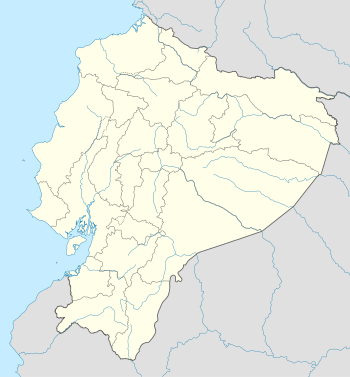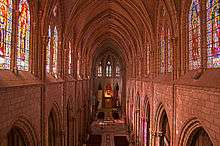Basílica del Voto Nacional
| Basilica of the National Vow Basílica del Voto Nacional (Spanish) | |
|---|---|
 | |
 Basilica of the National Vow Basílica del Voto Nacional (Spanish) Location in Ecuador | |
| Coordinates: 0°12′54″S 78°30′27″W / 0.214995°S 78.5074°W | |
| Location | Quito |
| Country | Ecuador |
| Denomination | Roman Catholic |
| History | |
| Consecrated | 1988 |
| Architecture | |
| Heritage designation | National Monument |
| Architect(s) | Emilio Tarlier |
| Style | Neogothic |
| Groundbreaking | 1892 |
| Specifications | |
| Length | 140 metres (460 ft) |
| Width | 35 metres (115 ft) |
| Height | 30 metres (98 ft) (sanctuary) |
| Spire height | 115 metres (377 ft) |
| Administration | |
| Archdiocese | Archdiocese of Quito |
The Basilica of the National Vow (Spanish: Basílica del Voto Nacional) is a Roman Catholic church located in the historic center of Quito, Ecuador. It is the largest neo-Gothic basilica in the Americas.
History

The basilica arose from the idea, proposed by father Julio Matovelle in 1883, of building a monument as a perpetual reminder of the consecration of Ecuador to the Sacred Heart. President Luis Cordero issued the decree on July 23, 1883, and it was carried out by president José María Plácido Caamaño on March 5, 1884. The congress, in accordance with the year's budget, designated 12,000 pesos for the construction - 1,000 pesos per month, beginning in 1884. By the decree of July 3, 1885, the fourth Quitense Provincial Council turned the construction of the basilica into a religious commitment in the name of the country. In 1887, the Issodum Fathers began construction for five years, with the approval of Pope Leo XIII. The Oblato fathers donated the land for the basilica. To continue construction, donations were accepted from believers, who provided stones in exchange for engraving their names on them. In 1895, the state established a tax on salt to continue the building.
In 1901, Father Matovelle and his Community of Missionary Monks, took charge of the construction at the request of Archbishop Pedro Rafael González Calisto. The building was designed by architect Emilio Tarlier at the cost of 40,000 French francs. Tarlier was inspired by the Bourges Cathedral. On July 10, 1892, the first stone was placed. Between 1892 and 1909, the Heart of Mary Cathedral was constructed. The basilica was blessed by Pope John Paul II on January 30, 1985, and it was consecrated[1] and inaugurated on July 12, 1988.
The basilica remains technically "unfinished."[2] Local legend says that when the Basílica is completed, the end of the world will come.

Description
The basilica is the most important work of neo-Gothic Ecuadorian architecture and is one of the most representative of the Americas. It is the largest neo-Gothic basilica in the New World. The building is noted for its grotesques in the form of native Ecuadorian animals such as armadillos, iguana, and Galapagos tortoises.
The Basilica is 140 m (460 ft) long and 35 m (115 ft) wide. It is 30 m (98 ft) high in the sanctuary, 15 m (49 ft) high in the votive chapels, 74 m (243 ft) high in the transept, and 115 m (377 ft) high in the two frontal towers. In the sanctuary, there are fourteen bronze images representing eleven apostles and three evangelists. In the crypt, there is a pantheon containing the remains of several heads of state.
Visitors are able to see the sanctuary for $1, while access to the rest of the Basilica ranges from $1–3. Visitors are able to climb to the top of the towers. From the highest point of the main tower, one can see the city and the surrounding mountains.
.jpg)
References
| Wikimedia Commons has media related to Basílica del Voto Nacional. |
- ↑ Basilica Travel Guide. Retrieved October 8, 2008.
- ↑ "La Basílica del Voto Nacional - Historical Building - Quito, Ecuador". Viva Travel Guides. Retrieved 31 December 2011.